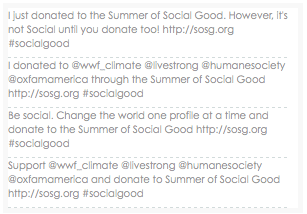What’s wrong with Mashable’s Summer of Social Good?
The desire to raise serious sums of money for charities (or non-profits as our American cousins might say) is a fantastic thing.
Animal rescue, tackling global poverty, protection of wildlife and the environment and funding cancer research and awareness are cracking causes that deserve every penny they get.
But after twenty years in fundraising, I'm sticking my neck out. Though I am going to sound a right miserable sod, I don't think – in its current form at least – Mashable's Summer of Social Good is going to raise much money. Not through normal everyday donors anyhow.
Here's why.
Mashable is an amazing resource that has proved its value over and over again by improving our understanding of social media. @Mashable on Twitter has (as I write) over 867,000 followers. Couple that with those who read the Mashable website and throw in a few dozen re-tweets and you have a serious body of people behind you.
But that's not all.
You can add GlobalGiving, the Social Media Club, Treehugger and even Facebook to the mix, as they are just a few of the partners involved in the summer long campaign.
The trouble is, the free transfer of information is not the same thing as the raising of funds. Though coming up with great ideas is hard work, we love to share them. It validates all those hours tapping away at the keyboard. Just ask any blogger. As soon as a post is up, you start checking your stats to see who is looking at it, where your referrals are coming from and how long people spend rummaging around the rest of your site.
Money is a different thing. Getting people to give it to charity is hard.
And, as a fundraiser, I know that simply putting four causes (no matter how great they are) in front of a donor isn't going to mean much money is going to change hands.
Take a look at some basic statistics from the traditional world of fundraising through direct marketing.
- The average highly personalised cold recruitment appeal sent to a targeted cold list presenting an emotional case for one particular organisation might generate a response of 1% or 2%.
- The average press insert – again presenting an emotional case for support – placed in an appropriate publication will generate a response rate of about 0.001% or 0.002%
- A strong display press ad will have a much lower response – perhaps 0.0001%. And often less.
- Then you have a tweet of 140 characters. Hardly enough to include the organisation's name and what the Summer of Social Good is about.
- That 867,000 might be expected to generate a cash response of about 0.000001%. That's about 1 (or maybe 2 people) / tweet. I'm not talking about click throughs here as they will be higher – I just think the number of actual gifts, based on my experience of other media, might really be this low (if you know better, please get in touch – I'd love to be shown I'm wrong).
- If @Mashable followers were asked ten times a day, that would generate up to 20 new gifts (at the higher end of my estimation). At $10 a go, that works out at $200 / day. Over the three months of the campaign, we might see $18,000 generated.
In the words of Kevin Keegan, I would love it if I was proved wrong. I love Twitter and I think @Mashable is a great resource and I want nothing but success for them both.
That's why, based on a fair amount of time at the coal face of raising funds, I would make the following recommendations to @Mashable about how they might improve the Summer of Social Good.
At the crux of the issue is the fact that people are most likely to give to charity when they feel involved and engaged. Normal tweets won't reach the emotional buttons that cause people to give. If fundraising was as simple as asking for money, I'd be doing a very different job (ideally something to do with shark research).
If Twitter is going to raise serious amounts of money (outside of emergencies) we need to recognise that a different type of relationship is required. So to pay back Mashable for the huge amount of great ideas they have shared with us, here are the top ten tips of a humble fundraiser on how to make the Summer of Social Good more effective.
1. Make the ask personally
A direct message (DM) is better than a normal tweet. If that message is from @Mashable it's certainly going to be read, particularly if they address the reader by name. Rather than just ask someone to give, ask the people that you DM to let you know if they are going to give or not. It's harder work than putting out a general tweet, but as I've said, fundraising isn't easy.
2. Show people you value them
The most basic sign of recognition on Twitter is to follow people. It shows you are interested in them and what they have to say. I still don't fully understand why some very large charities follow so few of their followers back – this isn't about broadcasting, it's about connection. Obviously you want to avoid the pirates and the Britney vids, but following is the start of a relationship. It's a huge number to manage, but effort equals reward.
You could, of course, set up a second account – one for the day job and one for charity work (see point 5 on how to make it look different).
3. Justify the ask
A broad "please give $20" (or even $10 or $5) is never as effective as giving donors something tangible to do. I've posted before on the benefits of earmarking a recruitment gift. Organisations such as Nothing But Nets and Charity:Water (the latter helped Twestival raise $250,000) have grown very quickly through making the most of our desire to do something "real" to help people in need. So rather than just asking for money, ask people to give to do something like planting a tree or provide a meal for a real person.
Tweetsgiving, for example, raised over $11,000 in 48 hours through taking a focus on building a single school in Tanzania by asking for $10 a brick (and getting support from over 100 press and blog sources).
4. If you can't justify the ask – make it personal and relevant
The charities that will benefit from the Summer of Social Good are in the big league – The Humane Society of the US, Oxfam America, WWF and the Lance Armstrong Foundation. They will be looking for unrestricted funds that they can spend on broad areas of work. This is not a great way to motivate people so I'd suggest looking at other ways to make the ask engaging.
One idea might be to place the focus on the donor and ask people to donate 1 cent for every follower they have as a sort of Twitter Tithe. It might be expensive for those with tens of thousands of followers, but would get people thinking. If you add a Twitter Tithe calculator you'll get people starting to interact as well.
It may even be something that might be attractive to the big twitter players who want to show they are doing their bit, which brings us to…
5. Give people a badge
The sticker on the lapel has worked as a means to thank and build social momentum for generations. In the UK , the poppy is seen everywhere in November and red noses sell in their millions raising money for Comic Relief. These symbols are so powerful that people feel left out if they aren't wearing them.
I've been impressed by the number of people going green with their Twitter icons in support of democracy in Iran. By giving people an opportunity to add a badge to their picture another reason for giving is created and the social momentum starts to build. A frame, flash or picture effect offered to people who give, could really help. These guys have the right idea.
Then give people a different badge
The credit card companies know that people like to be able demonstrate how rich or caring you are by what sort of card you use. Let people upgrade their badges when they give more money or recruit more people.
Anyone involved in fundraising knows that testing and re-testing messages is the key to success. Many people think that charities don't really know that much about metrics. They couldn't be more wrong. Real success comes from knowing your data inside out. The current range of sample tweets available could be better.
People might want to brag about how good they are, but it must be subtle. These sample tweets are just too direct to be attractive to the donors I know.
By testing and analysing response, we'll learn what works.
7. Let people help in the way that works for them
Ask people to choose different responsibilities – giving money, getting the message out, recruiting others to give, blogging. Social networks have been used to raise money for centuries and anyone who has ever managed an appeal committee knows that you get people to do what they are best at AND what they actually want to do in order to reach your goal. A registration that allows someone to define themselves with a role (with a set of responsibilities) is much more powerful than just asking for a re-tweet or a small donation. Which links neatly to…
8. Focus the landing page on the donor
There must be about twenty logos on the current landing page. It's about everyone else other than the donor. Click through to the charities and it's just about them and their work. In the bottom left hand corner of the landing page there are some of the latest tweets – but that's about it. Donors want to see and hear about what they can do (going back to points 3, 4 and 7). It is a subtle difference that makes the difference between success and failure.
It may be that some form of reporting back is part of the next stage of the plan. If it is, why not tell potential supporters about it. Which brings us to…
9. Show someone the impact they have made
Show supporters how their money has made a difference. The team at Charity:Water are excellent at this. Another charity that has a very donor focussed approach is MSF.
10. Show people you know them
Once someone has engaged with the Summer of Social Good, recognise the fact in every communication. Don't drop back into the easy but largely ineffective (for fundraising) mass tweeting. Twitter, like blogs, represents a means to start the realtionship. From then on it's back to fundraising basics.
And finally
I'm relatively new to Twitter and blogging and maybe I don't know as much as some of the experts. I might have a rather red face come the end of August, but I think far too many charities have forgotten the basics of fundraising when it comes to new media.
The majority of charity blogs, websites and twitter streams are about pumping out what the charity wants to say. It's when an organisation stops and asks the donor what they actually want to hear, that amazing things can happen. Twitter is a fantastic tool that allows us to listen (if we can be bothered to follow back our followers). I would suggest to charities that is where the secret of its power lies.
If you think I am misguided, mad or simply ignorant, please let me in on what you know.
Finally, if I've suggested things which are already in place, please accept my apologies.
Tags In
Related Posts
1 Comment
Comments are closed.
The Essentials

Crack the Code to Regular Giving: Insights, Strategies, and a Special Giveaway!

‘Tis Halloween. Keep to the light and beware the Four Fundraisers of the Apocalypse!

Why do people give? The Donor Participation Project with Louis Diez.

A guide to fundraising on the back of a postcard

What does the latest research tell us about the state of fundraising?







Hey, nice comments and thoughtful post. My response: http://occamsraiser.wordpress.com/2009/07/09/the-summer-of-social-good-thoughts/
Thanks!
Jana
—–
PING:
TITLE: Summer of Social Good: How good is it?
URL: http://kharma2001.typepad.com/laurie_land/2009/07/summer-of-social-good-how-good-is-it.html
IP: 10.17.151.33
BLOG NAME: Charity Chatter
DATE: 07/15/2009 03:43:14 AM
In my last blog, I promised to discuss my thoughts on Mashable’s Summer of Social Good. I may be stirring up a hornets nest, but it’s OK, I have an EpiPen! On June 20th’s Mark Phillips from Blue Frog, wrote…